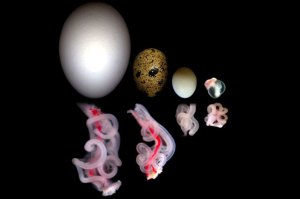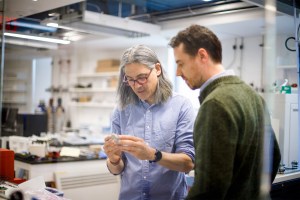Tag: Organismic Biology
-
Health
What’s behind the predictably loopy gut
Between conception and birth, the human gut grows more than two meters long, looping and coiling within the tiny abdomen. Within a given species, the developing vertebrate gut always loops into the same formation — however, until now, it has not been clear why.

-
Health
How does a worm build a throat?
Mention worms to most people, and they probably think of fishing, gardening, or trips to the vet. Mention them to Susan E. Mango, and she begins telling you how “absolutely…
-
Campus & Community
Take two: Brother’s keepers Bill and Dan Jones ’09, ’09
Complete strangers recognize Dan Jones on campus all the time. It’s the same for his brother, Bill. “I just play along,” said Dan. “I don’t know their names, I’ve never seen them before. I just assume Bill knows them and I try to be friendly so they don’t start hating him.”
-
Health
Bacteria have more to say than previously thought
Bacteria are the oldest living organisms, dating back 4 billion years. So it is only logical that they have evolved ways to communicate.
-
Science & Tech
The evolution of Darwin
In a fitting celebration of a man whose ideas revolutionized science, Harvard marked Charles Darwin’s 200th birthday in style.
-
Science & Tech
Records dating back to Thoreau show some sharp shifts in plant flowering near Walden Pond
Drawing on records dating back to the journals of Henry David Thoreau, scientists at Harvard University have found that different plant families near Walden Pond in Concord, Mass., have borne…
-
Health
Seeing what they hear, to better understand ourselves
It was a long drive from St. Louis to Florida, but Darlene Ketten had finally made it. Standing in the warm surf of St. George Island, she watched with delight as tiny, colorful bean clams popped out of the sand and then quickly reburied themselves as the waves foamed around her calves.
-
Campus & Community
Harvard faculty members net MacArthur fellowships
Three biologists — one current and two future faculty members at Harvard — have won MacArthur Foundation “genius” grants, $500,000 no-strings-attached awards intended to encourage creativity, originality, and innovation in a broad array of fields.
-
Campus & Community
Clark, Hewitt named AAAS Science & Technology Policy Fellows
Harvard affiliates Sharri Clark and David Hewitt have been named among the newest group of Science & Technology Policy Fellows by the American Association for the Advancement of Science (AAAS). The fellows spend a year working in federal agencies or congressional offices learning about science policy while providing valuable science and technology expertise to the…
-
Health
Boning up on frogs’ defenses
Harvard biologists have determined that some African frogs carry concealed weapons: when threatened, these species puncture their own skin with sharp bones in their toes, using the bones as claws…
-
Health
Telling the arthropod tale of life
They had sifted through the forest floor’s leaves and dirt for days, looking for a tiny type of daddy longlegs native to New Zealand, but had little more than dirty hands to show for it.
-
Health
First orchid fossil puts showy blooms at some 80 million years old
Biologists at Harvard University have identified the ancient fossilized remains of a pollen-bearing bee as the first hint of orchids in the fossil record, a find they say suggests orchids are old enough to have coexisted with dinosaurs.
-
Health
Species thrive when sexual dimorphism broadens niches
Some Caribbean lizards’ strong sexual dimorphism allows them to colonize much larger niches and habitats than they might otherwise occupy, allowing males and females to avoid competing with each other for resources and setting the stage for the population as a whole to thrive. The finding, reported this week in the journal Nature, suggests sex…
-
Health
Big brains better for birds
As you might guess, big-brained birds survive better in the wild than those less cerebral for their size. Scientists guessed that too, but they had to prove it to themselves.
-
Health
World’s largest flower evolved from family of much tinier blooms
The plant with the world’s largest flower – typically a full meter across, with a bud the size of a basketball – evolved from a family of plants whose blossoms are nearly all tiny, botanists write this week in the journal Science. Their genetic analysis of rafflesia reveals that it is closely related to a…
-
Campus & Community
Some like it hot: Deep-sea worms favor a fiery 45-55° c
Scientists have found that worms dwelling at deep-sea hydrothermal vents opt for temperatures of 45-55 degrees Celsius (113-131 degrees Fahrenheit) when provided a choice of conditions, giving them the highest…
-
Campus & Community
Evolution follows few possible paths to antibiotic resistance
Darwinian evolution follows very few of the available mutational pathways to attain fitter proteins, researchers at Harvard University have found in a study of a gene whose mutant form increases bacterial resistance to a widely prescribed antibiotic by a factor of roughly 100,000.
-
Campus & Community
Missing link crawls out of muck
Paleontologists have discovered fossils of a species that provides the missing evolutionary link between fish and the first animals that walked out of water onto land about 375 million years…


